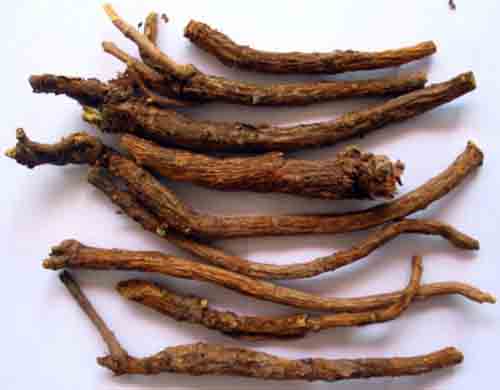The source is from the root of Astragalus membranaceus (Fisch.) Bunge var. mongholicus (Bunge) Hsiao, and A. membranaceus (Fisch.) Bunge, family Leguminosae. It mainly grows in Inner Mongolia, Shanxi, Gansu and Heilongiiang, etc., harvested in spring and autumn, sliced and dried with removal of head and fine roots. It is used crudely or roasted with honey for use.
Medicinal Properties: Sweet in flavor, slightly warm in nature, and attributive to the spleen and lung meridians.
Actions: Replenish qi to invigorate yang; benefit the lung to strengthen the body; promote diuresis and relieve edema; relieve skin infection and promote tissue regeneration.

Application
1. It is used for the syndrome with qi-deficiency of the spleen and lung, and visceroptosis with hyposplenic qi manifested as fatigue and weakness due to prolonged illness, it is used together with Renshen (Radix Ginseng), such as Shen Qi Gao (Soft extract); for that accompanied by deficiency of yang manifested as chill, fatigue and polyhidrosis, it is used with Fuzi (Radix Aconiti Lgterglis Praeoarata),such as Qi Fu Gao (Soft extract). For deficiency of both qi and blood, it is used together with Danggui (Radix Angelicae Sinensis ). For deficiency of spleen-qi manifested as poor appetite, loose stool or diarrhea, it is used together with Baizhu (Rhizoma Atractylodis Macrocephalae), such as Qi Zhu Gao (Soft extract). For descending of spleen-yang, visceroptosis with hyposplenic qi, prolaps of uterus, and prolaps of rectum due to chronic diarrhea, it is used with Renshen (Radix Ginseng), Baizhu (Rhizoma Atractylodis Macrocephalae ), Shengma (Rhizoma Cimicifugae ), and Chaihu ( Radix Bupleuri), etc., such as Buzhong Yiqi Tang (Decoction). For deficiency of qi resulting in inability to govern the blood manifested as bloody stool and metrorrhagia and metrostaxis, it may be used together with Renshen (Radix Ginseng), Suanzaoren ( Semen Ziziphi Spinosae ) and Guiyuanrou (Aritlus Longan), etc., such as Guipi Tang (Decoction).
2. It is applied for cough due to lung deficiency, superficies-asthenia with profuse sweating, or night sweating. For deficiency of lung qi with cough or shortness of breath or dyspnea, it is frequently used with Ziwan (Radix Asteris ), Wuweizi ( Fructus Schisandrae ), etc. for superficies-asthenia with profuse sweating and suspectility to common cold, it is used with Baizhu (Rhizoma Atractylodis Macrocephalae ) and Fangfeng (Radix Saposhnikoviae), such as Yupingfeng San (Powder); for night sweating, it can be used with Shengdihuang (Radix Rehmannia), Huangbai ( Cortex Phellodendri ), etc., such as Danggui Liuhuang Tang (Decoction).
3. It is applied for maltransformation of water and dampness due to deficiency of qi with facial edema, oliguria or palpitation, and dyspnea. And it is used together every time with Fangji (Radix Stephaniae Tetrandrae ) , Baizhu (Rhizoma Atractylodis Macrocephalae ) , etc., such as Fangji Huangqi Tang (Decoction). It is remarkably effective for edema from chronic nephritis with presence of protein in urine for a long time.

4. It is applied for unruptured carbuncle or ruptured but unhealed one due to deficiency of qi and blood. For unruptured carbuncle, it is often used together with Danggui ( Radix Angelicae Sinensis ), Zaojiaoci ( Spina Gleditsiae), etc., such as Tounong San (Powder). For ruptured carbuncle with watery pus and no tendency to healing, it can be used with Danggui (Radix Angelicae Sinensis ), Renshen ( Radix Ginseng ), and Rougui (Cortex Cinnamomi ), etc., such as Shiquang Dabu Tang (Decoction).
5. For numbness of limbs and hemiplegia due to deficiency of qi and stagnation of blood, it is often used with Guizhi ( Ramulus Cinnamomi ), Baishaoyao ( Radix Paeoniae Alba ), etc., such as Huangqi Guizhi Wuwu Tang (Decoction); or used with Danggui (RadixAngelicae Sinensis ), Honghua ( Flos Carthami ) and Taoren ( Semen Persicae), etc., such as Buyang Huanwu Tang (Decoction).
In addition, it is also used for treating diabetes in combination with Shengdihuang ( Radix Rehmannia ), Maimendong ( Radix Ophiopogonis), Tianhuafen (Radix Trichosanthis), and Shanyao ( Rhizoma Dioscoreae ), etc..
Usage and Dosage:
Decoction. 10-15 g or up to 30 -60 g is used crudely in general; but honey-roasted one is selected for the purpose of replenishing qi and invigorating yang.
Notes:
Contraindicated in the case with superficialsthenia syndrome with excessive pathogenic factors, stagnation of qi and dampness, indigestion, hyperactivity of yang due to deficient yin, onset of carbuncle at the early stage or one ruptured but unhealed for a long time with excessive heat-toxin.







